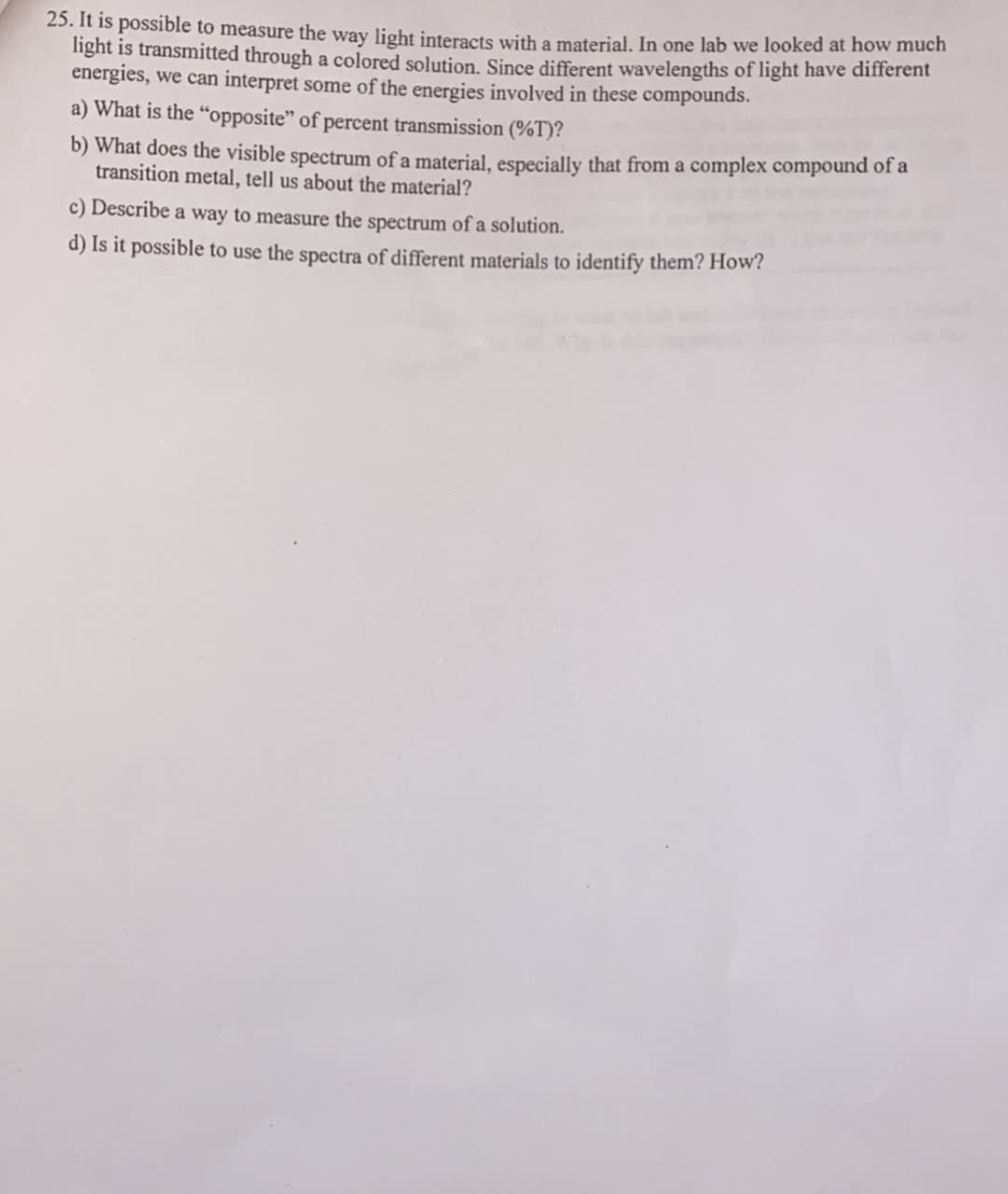25. It is possible to measure the way light interacts with a material. In one lab we looked at how much light is transmitted through a colored solution. Since different wavelengths of light have different energies, we can interpret some of the energies involved in these compounds. a) What is the "opposite" of percent transmission (%T)? b) What does the visible spectrum of a material, especially that from a complex compound of a transition metal, tell us about the material? c) Describe a way to measure the spectrum of a solution.
25. It is possible to measure the way light interacts with a material. In one lab we looked at how much light is transmitted through a colored solution. Since different wavelengths of light have different energies, we can interpret some of the energies involved in these compounds. a) What is the "opposite" of percent transmission (%T)? b) What does the visible spectrum of a material, especially that from a complex compound of a transition metal, tell us about the material? c) Describe a way to measure the spectrum of a solution.
Principles of Modern Chemistry
8th Edition
ISBN:9781305079113
Author:David W. Oxtoby, H. Pat Gillis, Laurie J. Butler
Publisher:David W. Oxtoby, H. Pat Gillis, Laurie J. Butler
Chapter22: Inorganic Materials
Section: Chapter Questions
Problem 26P
Related questions
Question

Transcribed Image Text:25. It is possible to measure the way light interacts with a material. In one lab we looked at how much
light is transmitted through a colored solution. Since different wavelengths of light have diferent
energies, we can interpret some of the energies involved in these compounds.
a) What is the "opposite" of percent transmission (%T)?
b) What does the visible spectrum of a material, especially that from a complex compound of a
transition metal, tell us about the material?
c) Describe a way to measure the spectrum of a solution.
d) Is it possible to use the spectra of different materials to identify them? How?
Expert Solution
This question has been solved!
Explore an expertly crafted, step-by-step solution for a thorough understanding of key concepts.
This is a popular solution!
Trending now
This is a popular solution!
Step by step
Solved in 4 steps

Knowledge Booster
Learn more about
Need a deep-dive on the concept behind this application? Look no further. Learn more about this topic, chemistry and related others by exploring similar questions and additional content below.Recommended textbooks for you

Principles of Modern Chemistry
Chemistry
ISBN:
9781305079113
Author:
David W. Oxtoby, H. Pat Gillis, Laurie J. Butler
Publisher:
Cengage Learning

General Chemistry - Standalone book (MindTap Cour…
Chemistry
ISBN:
9781305580343
Author:
Steven D. Gammon, Ebbing, Darrell Ebbing, Steven D., Darrell; Gammon, Darrell Ebbing; Steven D. Gammon, Darrell D.; Gammon, Ebbing; Steven D. Gammon; Darrell
Publisher:
Cengage Learning

Chemistry & Chemical Reactivity
Chemistry
ISBN:
9781133949640
Author:
John C. Kotz, Paul M. Treichel, John Townsend, David Treichel
Publisher:
Cengage Learning

Principles of Modern Chemistry
Chemistry
ISBN:
9781305079113
Author:
David W. Oxtoby, H. Pat Gillis, Laurie J. Butler
Publisher:
Cengage Learning

General Chemistry - Standalone book (MindTap Cour…
Chemistry
ISBN:
9781305580343
Author:
Steven D. Gammon, Ebbing, Darrell Ebbing, Steven D., Darrell; Gammon, Darrell Ebbing; Steven D. Gammon, Darrell D.; Gammon, Ebbing; Steven D. Gammon; Darrell
Publisher:
Cengage Learning

Chemistry & Chemical Reactivity
Chemistry
ISBN:
9781133949640
Author:
John C. Kotz, Paul M. Treichel, John Townsend, David Treichel
Publisher:
Cengage Learning

Chemistry & Chemical Reactivity
Chemistry
ISBN:
9781337399074
Author:
John C. Kotz, Paul M. Treichel, John Townsend, David Treichel
Publisher:
Cengage Learning

Chemistry: An Atoms First Approach
Chemistry
ISBN:
9781305079243
Author:
Steven S. Zumdahl, Susan A. Zumdahl
Publisher:
Cengage Learning
